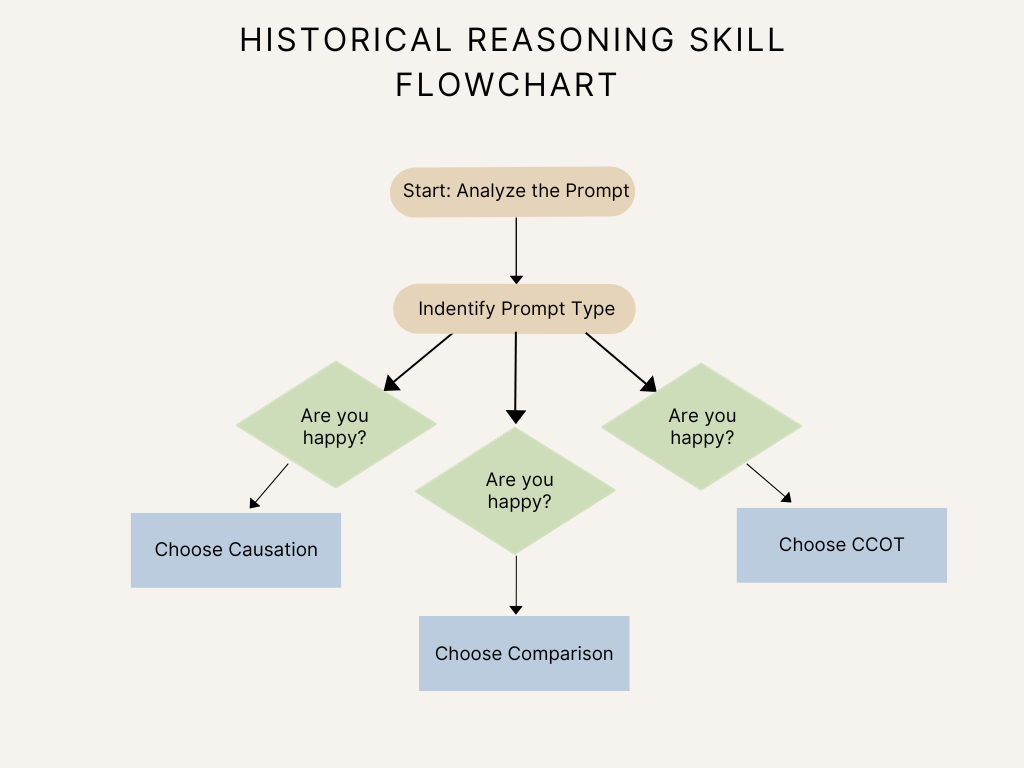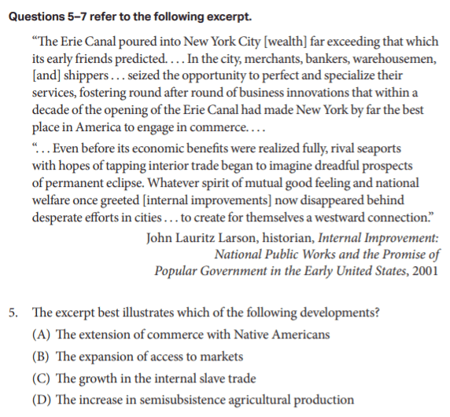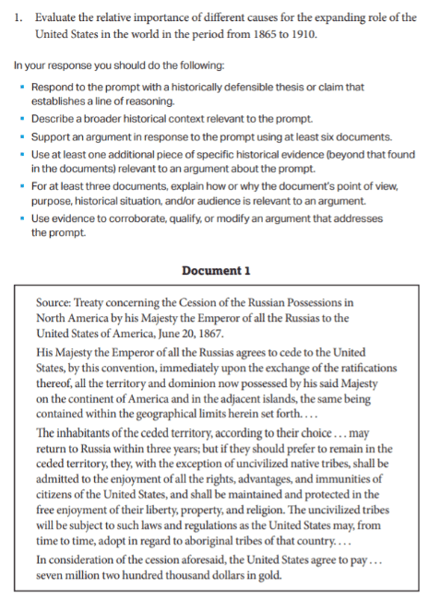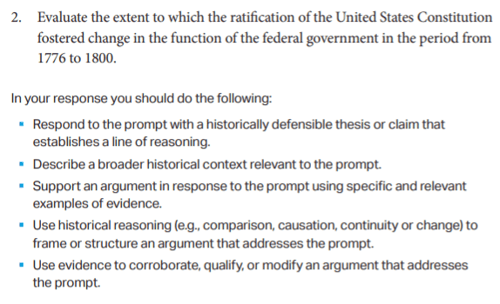Find what you need to study

AP History LEQ: Analysis and Reading
1 min read • december 8, 2023
Mixed AP Review
Endless stimulus-based MCQs for all units
⭐️ Crafting a structured argument is crucial. Dive deep into the nuances of using reasoning skills to enhance your writing and make your arguments stand out!
📜 Analysis and Reasoning: Historical Reasoning
What does an argument consist of.
- A good argument requires structure, necessitating one of the course reasoning skills to create that structure. You can choose whichever skill works best for a particular prompt: causation , comparison , or continuity and change over time .
How do I know if my reasoning is good?
- Strong reasoning goes throughout an essay, so this will be the overarching structure of your writing from the thesis through your body paragraphs.
- The reasoning doesn’t necessarily have to be completely balanced or even in order to count, which gives you room to write about what you know best. For example, in an essay structured around continuity and change, you might spend most of your time addressing changes and relatively little time addressing continuity. And that’s ok.
- The best essays do address both “sides” of the historical reasoning, and yours should too. If you created a complex thesis in your introduction, you can extend those ideas into your body paragraphs. Even if you don’t have equal sentences or paragraphs for each topic, as long as you address the reasoning process in your essay, you’re on the right track.
Reasoning Skills:
- Example: Choose this when a prompt asks about the reasons behind a specific event.
- Example: Ideal for prompts asking for an analysis of two different, yet related events or periods.
- Example: Use this when the prompt is about the evolution or persistence of certain aspects over a period.

Courtesy of Nora
🛎️ Selecting the Right Reasoning Skill
- Every historical prompt comes with its own unique flavor. Thus, depending on the nuances of the question, you might lean towards causation (unraveling the 'why' behind events), comparison (contrasting and juxtaposing entities/events), or continuity and change over time (decoding the transformations and constants over a timeline).
- But how do you ascertain that your choice hits the bullseye? The strength of your reasoning should cascade throughout your essay, crafting a cohesive thread from the introduction to the conclusion.
- Remember, perfection doesn’t always equate to balance. You might pivot more towards changes and brush over continuities, or vice versa. This choice is not a sign of weakness; instead, it shows you're strategizing based on your strengths.
- Nevertheless, aim to touch upon both dimensions of your chosen reasoning skill. Even if you veer more towards one side, ensuring a nod to the other aspect accentuates the depth and comprehensiveness of your argument.
💎 Elevate Your Argument
- 🎯 Crafting a Complex Thesis : Root your essay in a thesis that's not just a statement but a promise of a journey. This thesis should be a preview of the intricate tapestry of ideas you're about to weave.
- 🤓 Integrating Ideas : As you venture into the body of your essay, ensure a seamless flow. Ideas should not just follow one another; they should converse, contest, and converge.
- 📚 Evidence Selection : While it’s pivotal to have a wealth of information, discernment in choosing the most impactful evidence amplifies your argument's potency. Each piece of evidence should not just support but elevate your argument.
- 🪄 Concluding with a Punch : Your conclusion is not just a summary. It's the final note that resonates, the crescendo of your symphony. Ensure it leaves an impression, encapsulating the essence of your argument and its significance.
💡 Pro Tip: Practice makes perfect. Regularly engage with diverse historical prompts. Experiment with different reasoning skills. Over time, you’ll develop an intuitive knack for selecting the best strategy for any given topic.

Stay Connected
© 2024 Fiveable Inc. All rights reserved.
AP® and SAT® are trademarks registered by the College Board, which is not affiliated with, and does not endorse this website.
If you're seeing this message, it means we're having trouble loading external resources on our website.
If you're behind a web filter, please make sure that the domains *.kastatic.org and *.kasandbox.org are unblocked.
To log in and use all the features of Khan Academy, please enable JavaScript in your browser.
AP®︎/College US History
Course: ap®︎/college us history > unit 10, ap us history periods and themes.
- AP US History multiple choice example 1
- AP US History multiple choice example 2
- AP US History short answer example 1
- AP US History short answer example 2
- AP US History DBQ example 1
- AP US History DBQ example 2
- AP US History DBQ example 3
- AP US History DBQ example 4
- AP US History long essay example 1
- AP US History long essay example 2
- AP US History long essay example 3
- Preparing for the AP US History Exam (5/4/2016)
- AP US History Exam Prep Session (5/1/2017)
AP US history periods and themes
Example ap us history problems, key terms, documents, and court cases to know, primary documents:.
John Winthrop, “City on a Hill” / “A Model of Christian Charity”
Jonathan Edwards, “Sinners in the Hands of an Angry God”
Thomas Jefferson, “Declaration of Independence”
James Madison, “Constitution of the United States”
Elizabeth Cady Stanton and Susan B. Anthony, “Declaration of Sentiments”
Frederick Douglass, “What to the Slave is the Fourth of July?”
Harriet Beecher Stowe, “Uncle Tom’s Cabin” (main ideas)
Abraham Lincoln, “House Divided” speech, Second Inaugural Address
Sojourner Truth, “Ain’t I a Woman?”
Andrew Carnegie, “The Gospel of Wealth” (main ideas)
Josiah Strong, “Our Country” (main ideas)
Upton Sinclair “The Jungle” (main ideas)
Franklin Delano Roosevelt, First Inaugural Address, December 8 1941 address
George Kennan, “Long Telegram”
Martin Luther King Jr. “Letter from Birmingham Jail”, “I Have a Dream” speech
Betty Friedan “The Feminine Mystique” (main ideas)
Ronald Reagan “Evil Empire” speech
Supreme Court cases:
Marbury v. Madison
Dred Scott v. Sanford
Plessy v. Ferguson
Brown v. Board of Education
Roe v. Wade
Bush v. Gore
Foreign policy doctrines:
Monroe Doctrine
Roosevelt Corollary to the Monroe Doctrine
Truman Doctrine
Nixon Doctrine
Bush Doctrine
virgin soil epidemic
salutary neglect / benign neglect
mercantilism
Anti-Federalist
isolationism
judicial review
Democratic-Republican
Jacksonian Democracy
nullification
popular sovereignty
Emancipation
Jim Crow segregation
sharecropping
mass production
labor union
imperialism
self-determination
prohibition
laissez-faire economics
liberalism (economics/politics)
Soviet Union
containment
Domino Theory
non-violent protest (Civil Rights)
Vietnamization
conservatism
Want to join the conversation?
- Upvote Button navigates to signup page
- Downvote Button navigates to signup page
- Flag Button navigates to signup page


APUSH Long Essay Question Example 2
Evaluate the extent to which the civil war was a turning point in the history of the united states in the period from 1800 to 1877..
- What were the major events leading up to the Civil War?
- How did the Civil War change political, economic, and social structures in the U.S.?
- What were the immediate and long-term consequences of the Civil War?
- Were there any other significant turning points during this period? How do they compare to the Civil War?
- How did the Reconstruction era that followed the Civil War further shape the nation?
- Thesis/Claim (1 point): The APUSH exam requires students to present a clear, precise, and defensible thesis in their essay. In the sample essay, the thesis is evident in the statement, “The Civil War, fought between 1861 and 1865, stands as a monumental turning point in the history of the United States.” This thesis directly addresses the prompt and sets the stage for the arguments that follow.
- Contextualization (1 point): To earn this point, students must describe a broader historical context relevant to the prompt. The essay does this by outlining the tensions between the North and the South, mentioning key events like the Missouri Compromise and the Compromise of 1850. This provides readers with a clear backdrop against which the main arguments of the essay are set.
- Evidence (2 points): The APUSH standards require students to support their thesis with specific evidence. In the sample essay, there’s a plethora of evidence cited, such as the election of Abraham Lincoln, the Emancipation Proclamation, the Homestead Act, and the Reconstruction Amendments. Each piece of evidence is directly related to the thesis and supports the argument that the Civil War was a significant turning point.
- Analysis and Reasoning (2 points): This is where students must demonstrate a deeper understanding of the topic. The essay does this in two ways. First, it analyzes the significance of each piece of evidence, explaining, for example, how the Emancipation Proclamation and the 13th Amendment changed the lives of African Americans. Second, it shows a complex understanding by comparing the impact of the Civil War to other events of the period, such as the Market Revolution and the Second Great Awakening. This comparison not only reinforces the thesis but also provides a nuanced view of the period.
When you are done reviewing this APUSH LEQ example, you can use the buttons below to proceed to our Long Essay example 3 or return to the Practice Exam main menu.

Choose Your Test
Sat / act prep online guides and tips, the ultimate guide to the ap us history exam.
Advanced Placement (AP)

The AP US History exam involves critical reading, writing, and in-depth analysis. It's not just about memorizing names and dates, but rather interpreting historical evidence quickly and accurately, recalling outside information on a topic, and synthesizing your ideas into a coherent argument.
In this guide, we'll give you a rundown of the format and structure of the AP US History test along with a brief content outline, sample questions, and some tips for a great score .
How Is the AP US History Exam Structured?
The next AP US History test will be administered on Friday, May 5, 2023, at 8 AM . This AP exam is three hours and 15 minutes long and consists of two main sections, each of which is divided into a Part A and a Part B.
Before we get into the details of each part, here's an overview of the US History test as a whole:
Section 1, Part A: Multiple Choice
The first section on the test is the multiple-choice section, which is worth 40% of your score and lasts for 55 minutes. You'll get 55 questions, each with four possible answer choices (labeled A-D); this means that you'll have about a minute per question on this part of the exam.
Most US History multiple-choice questions come in sets of three to four questions that require you to respond to certain stimuli, or sources, such as historical texts, graphs, and maps.
Section 1, Part B: Short Answer
Part B of Section 1 on the US History test requires you to answer three short-answer questions in 40 minutes , giving you about 13 minutes per question. It's worth 20% of your overall score.
The first two questions are required, but you get to choose between question 3 and question 4 for your third short answer . Here's what you can expect with each question:
Section 2, Part A: Document-Based Question
The Document-Based Question, or DBQ , is worth 25% of your final score and requires you to write an essay based on a prompt that's accompanied by seven historical documents . You'll get a 15-minute reading period followed by 45 minutes to write your response.
The DBQ will focus on a historical development in the years 1754-1980.
Section 2, Part B: Long Essay
The final part of the AP US History test is the Long Essay, for which you must choose one of three possible prompts and write an essay on the topic. You'll have 40 minutes to write your response, which will count for 15% of your overall AP score.
To earn full credit here, you must develop a clear and logical argument and support it with relevant historical evidence (which won't be directly provided to you as it will be on the DBQ).
Each of the three essay prompts revolves around a different time period in US history:
- Essay Prompt 1: 1491-1800
- Essay Prompt 2: 1800-1898
- Essay Prompt 3: 1890-2001
Content Background for the AP US History Exam
There are eight themes addressed in the AP US History course , and all of them show up in one form or another on the exam across the nine units, or time periods . Each represents a subset of learning objectives that students are expected to master. You can read more about these learning objectives in the AP US History Course and Exam Description .
Before I give you a broad overview of the eight themes, let's take a look at how the major units are weighted on the AP US History exam :
Below, we give you the definition of each course theme as described in the AP US History Course Description.
Theme 1: American and National Identity
Focuses on how and why definitions of American and national identity and values have developed among the diverse and changing population of North America as well as on related topics, such as citizenship, constitutionalism, foreign policy, assimilation, and American exceptionalism.
Theme 2: Work, Exchange, and Technology
Focuses on the factors behind the development of systems of economic exchange, particularly the role of technology, economic markets, and government.
Theme 3: Geography and the Environment
Focuses on the role of geography and both the natural and human-made environments in the social and political developments in what would become the United States.
Theme 4: Migration and Settlement
Focuses on why and how the various people who moved to and within the United States both adapted to and transformed their new social and physical environments.
Theme 5: Politics and Power
Focuses on how different social and political groups have influenced society and government in the United States as well as how political beliefs and institutions have changed over time.
Theme 6: America in the World
Focuses on the interactions between nations that affected North American history in the colonial period and on the influence of the United States on world affairs.
Theme 7: American and Regional Culture
Focuses on how and why national, regional, and group cultures developed and changed as well as how culture has shaped government policy and the economy.
Theme 8: Social Structures
Focuses on how and why systems of social organization develop and change as well as the impact that these systems have on the broader society.

Sample AP US History Questions
Now that you have a sense of the test content, I'll present you with sample questions to give you a better idea of what the AP US History exam actually looks like. All sample questions come from the official US History Course and Exam Description .
Sample Multiple-Choice Question
For multiple choice, you're given one or two pieces of historical evidence followed by a set of questions that ask you to do some analysis . The US History exam is less about knowing specific dates and names and more about being able to draw conclusions and connect themes based on materials provided by the test.

To answer this question, you don't even really need to know much about US history, as long as you pay attention to exactly what's written in the passage, or the secondary source you've been given. The passage here is mainly focused on the increase in commerce in New York as a result of the opening of the Erie Canal.
Answer choice A mentions commerce—that's a good sign—but specifically commerce with Native Americans, who are not mentioned at all in the passage, so this is unlikely to be the right answer.
Answer choice B discusses increased access to markets in the United States, which seems to echo what the passage says about commerce in New York. We'll hold onto this as a potential answer.
Answer choice C is all about the internal slave trade, which isn't mentioned at all in the secondary source, so we can assume this is wrong.
Answer choice D talks about agricultural production, which, again, isn't the focus of the passage—that's commerce. As a result, we can cross this off our list.
This means that the only logical answer to choose is answer choice B .

Sample Short-Answer Question
The short-answer questions are technically considered part of the multiple-choice section because they're less involved than the essay questions. Alt hough they do have multiple parts, you don't have to come up with a thesis—one-sentence answers are OK. These questions are about succinctly connecting themes and reference materials to specific events or trends.
Here's an example:

This short-answer question is an example of question 1, which comes with two secondary sources. As you can see, you'll have to answer three separate parts (A, B, and C), each of which is worth 1 point ; this means you can earn up to 3 points for each short-answer question.
Here's how you could earn full credit for this sample question, per the official scoring guidelines .
(A) Sample Answers
- Peiss argues that pursuits of entertainment in dance halls by working class women created new, legitimate social spaces for women, however Enstand argues that working women's participation in labor politics gave them a new voice and place in the public sphere.
- Peiss links the growth of women in public social life to a commercial culture that provided opportunities for women to enter the public sphere while Enstand argues that women became political actors who demanded a public voice.
(B) Sample Answers
- Like the dance halls, department stores and amusement parks became aspects of the commercial culture that represented new opportunities for women to enjoy public places as legitimate participants.
- The concept of the New Woman became a cultural phenomenon, as the older idea of separate spheres diminished. The idea of the New Woman supported a more public role for women in the early 1900s.
- The growth of cities and urban America gave young women more opportunities to leave rural America and participate in the developments described by Peiss.
- New technologies such as electric lighting made possible new public spaces for personal freedom for women.
(C) Sample Answers
- Women's participation in the suffrage movement, settlement house work, temperance organizing, and the Progressive movement all contributed to modern attitudes about women and increased their roles in the public sphere.
- The ratification of the Nineteenth Amendment to the Constitution gave women the vote and a voice in politics.
- Women were the main participants in the New York shirtwaist strike of 1909. During this strike women made public demands like those described by Enstad.
- Women organized or participated in labor unions such as the International Ladies' Garment Workers' Union (ILGWU) which is an example of their growing voice in the public sphere.
- Working-class women had key public roles in the successful Lawrence (Massachusetts) textile strike of 1912, this demonstrates that women became active political voices through labor movements.

Sample Document-Based Question
With the DBQ , you'll have seven different historical documents to examine . To earn full credit, you must use at least six documents as evidence in your answer. These documents range from transcripts of folk songs, to excerpts from letters and newspapers, to demographic maps.
Here's an example of a DBQ (with one document shown):

There are several components of a solid response to this question. The DBQ is worth a total of 7 raw points . Here's how you could earn full credit, according to the scoring guidelines .
Sample Long Essay Question
For the Long Essay, you must choose between three prompts . Here's an example of a potential prompt:

Your essay should include many of the same elements as your answer to the DBQ, but there are no documents to analyze and reference , so you'll have less time to write. The essay is worth 6 raw points .
Here's how you could earn full credit for the sample question above, per the scoring guidelines .

How Is the AP US History Exam Scored?
Here, we'll go over how each section on the AP US History exam is scored, scaled, and combined to give you your final AP score on the 1-5 scale .
On the multiple-choice section, you earn 1 raw point for each question you answer correctly; this means that the max score you can earn here is 55 points. No points are taken off for incorrect answers.
Each of the three short-answer questions is worth 3 points, so there are 9 points possible in this section.
The DBQ is scored out of 7 points and is based on the following criteria, per the scoring guide :
- Thesis/claim: 1 point
- Contextualization: 1 point
- Evidence from the documents: 2 points
- Evidence beyond the documents: 1 point
- Sourcing: 1 point
- Complexity: 1 point
Lastly, the Long Essay is out of 6 raw points and is scored using the following criteria:
- Evidence: 2 points
- Analysis and reasoning: 2 points
On essay questions, points are taken off for errors only if they detract from the quality of the argument being made (in other words, don't go making up historical facts to support your argument). Grammatical and other technical errors aren't a big deal as long as they don't inhibit the grader's ability to understand what your essay is saying.
The total number of raw points you can earn on the AP US History test is 77:
- 55 points for the Multiple Choice questions
- 9 points for the Short Answer questions
- 7 points for the DBQ
- 6 points for the Long Essay
Raw scores can be converted to scaled scores out of 150 . Here's how to do that for each section:
- Multiple Choice: Multiply your raw multiple-choice section score out of 55 by 1.09
- Short Answer: Multiply your raw short-answer score out of 9 by 3.33
- DBQ: Multiply your raw DBQ score out of 7 by 5.36
- Long Essay: Multiply your raw Long Essay score out of 6 by 3.75
Finally, add all the scores together to get your final scaled AP score for US History! Here is a chart to show you approximately how these scaled scores translate to final AP scores:
Source: The College Board
I made my best estimates based on other AP score conversion charts because there was no official scaled-to-AP-score conversion chart online for US History. Your AP teacher or review book might have a more accurate score conversion system you can use for official practice tests.
4 Essential Tips for Acing the AP US History Exam
AP US History is a grueling test that requires intense critical thinking and analytical skills. Here are some helpful tips to remember if you hope to do well on test day.
#1: Don't Confuse Accurate Facts for Correct Answers
Many multiple-choice questions will list answers that are accurate representations of historical events or trends but that don't directly respond to the question being asked . Be wary of these answers on the test so you don't accidentally choose them over more relevant responses.
In the multiple-choice question I gave above as an example, one incorrect choice was "The growth in the internal slave trade." At the time referenced in the question, this was a real trend that occurred, but because it doesn't relate directly to the passage given, it's still the wrong answer .
Don't let these types of answer choices confuse you; adhere to the particulars of the question and the evidence presented to you!
#2: Pay Attention to Details—Read Excerpts Carefully
Most of this AP exam is based on historical reference materials, meaning that you won't be able to answer questions correctly without reading carefully. Even if you know everything there is to know about US History, that knowledge will mostly just serve to contextualize the evidence presented on the test. The specific details found in the writings and images will ultimately reveal the best answer choice.
#3: Plan Before You Write
It's critical to write well-organized, focused essays on the AP US History test. A clear thesis is the first thing on the agenda. You then need to make sure that the rest of your essay ties back into your thesis and provides relevant evidence throughout. If you jump into writing an essay without taking the time to organize your thoughts, you're more likely to ramble or get off-topic from the main focus of the question.
For the DBQ, you should spend 15 of the 60 minutes planning how to organize your thoughts and how to use the different documents as evidence. While you will have less time for the Long Essay, you should still spend five minutes or so writing a brief outline before starting your final draft.
#4: Use Outside Evidence Wisely
It's a smart idea to incorporate additional background knowledge into your DBQ and Long Essay responses on the AP US History test. It shows that you've mastered the material and can connect themes to what you learned in class and not just what was presented to you in the question.
That said, don't include outside knowledge unless it really bolsters your argument . If you're just sticking it in there to prove how much you know, your essay will lack focus and you might lose points.
This is why it's so important to plan ahead. In the planning stage, you can think of examples that tie into your thesis and strategically place them throughout your essay in ways that contribute to your point.

Conclusion: Getting a Great Score on the AP US History Exam
The AP US History exam is one of the longer AP tests, and it has four different types of questions: Multiple Choice, Short Answer, Document-Based Question (DBQ), and Long Essay.
The main thread running through this test is an emphasis on analyzing historical evidence and applying outside knowledge in context. In your studying, you will need to learn to connect the themes of the course to events spanning 500 years of US history.
Here are some study tips to heed as you prep for the AP US History test:
- Don't mistake accurate facts for correct answers
- Always read excerpts carefully
- Plan before writing your essays
- Use outside evidence strategically
Make sure that you practice all the different types of exam questions with official materials before you sit down to take the real test . If you get used to thinking about history in an analytical, evidence-based context, you should have no problem earning a high US History score!
What's Next?
Looking for more practice materials? Check out our article on the best online quizzes you can take to prepare for the AP US History test !
Review books can be extremely helpful tools in preparing for AP exams. If you can't decide which one to get, take a look at this list of the best review books for the AP US History test .
Did you lose some of your notes? Feel free to use these links to AP US History notes for every section of the course .

Samantha is a blog content writer for PrepScholar. Her goal is to help students adopt a less stressful view of standardized testing and other academic challenges through her articles. Samantha is also passionate about art and graduated with honors from Dartmouth College as a Studio Art major in 2014. In high school, she earned a 2400 on the SAT, 5's on all seven of her AP tests, and was named a National Merit Scholar.
Student and Parent Forum
Our new student and parent forum, at ExpertHub.PrepScholar.com , allow you to interact with your peers and the PrepScholar staff. See how other students and parents are navigating high school, college, and the college admissions process. Ask questions; get answers.

Ask a Question Below
Have any questions about this article or other topics? Ask below and we'll reply!

Improve With Our Famous Guides
- For All Students
The 5 Strategies You Must Be Using to Improve 160+ SAT Points
How to Get a Perfect 1600, by a Perfect Scorer
Series: How to Get 800 on Each SAT Section:
Score 800 on SAT Math
Score 800 on SAT Reading
Score 800 on SAT Writing
Series: How to Get to 600 on Each SAT Section:
Score 600 on SAT Math
Score 600 on SAT Reading
Score 600 on SAT Writing
Free Complete Official SAT Practice Tests
What SAT Target Score Should You Be Aiming For?
15 Strategies to Improve Your SAT Essay
The 5 Strategies You Must Be Using to Improve 4+ ACT Points
How to Get a Perfect 36 ACT, by a Perfect Scorer
Series: How to Get 36 on Each ACT Section:
36 on ACT English
36 on ACT Math
36 on ACT Reading
36 on ACT Science
Series: How to Get to 24 on Each ACT Section:
24 on ACT English
24 on ACT Math
24 on ACT Reading
24 on ACT Science
What ACT target score should you be aiming for?
ACT Vocabulary You Must Know
ACT Writing: 15 Tips to Raise Your Essay Score
How to Get Into Harvard and the Ivy League
How to Get a Perfect 4.0 GPA
How to Write an Amazing College Essay
What Exactly Are Colleges Looking For?
Is the ACT easier than the SAT? A Comprehensive Guide
Should you retake your SAT or ACT?
When should you take the SAT or ACT?
Stay Informed
Get the latest articles and test prep tips!
Looking for Graduate School Test Prep?
Check out our top-rated graduate blogs here:
GRE Online Prep Blog
GMAT Online Prep Blog
TOEFL Online Prep Blog
Holly R. "I am absolutely overjoyed and cannot thank you enough for helping me!”
How to Prep for APUSH Essays

Preparation is key to writing a quality APUSH essay. Knowing what and how to write are both skills that you can improve and cultivate through practice. Use the following suggestions to help you prep for your upcoming APUSH essays.
APUSH essays: long essay, short answer or DBQ?
APUSH exams actually contain three different types of essays: long essay, short answer and Data-Based Question (DBQ) . Each asks you to analyze and synthesize historical data, but vary in response format and content. Visit AP College Board to take a closer look at individual APUSH essay requirements.
Short Answer Response: 3 questions, 40 minute response time
Technically, short answer is not an essay at all, but rather a paragraph (or two) that concisely explain your ideas on a topic or prompt. Even though you are not writing a full-length essay for this section, keep in mind that your response still needs to read coherently and maintain focus – just like a standard writing. Short answer responses require three individual answers (parts A, B, C), each worth one point.
Data-based Question Essay: 1 question, 60 minutes response time
The DBQ essay focuses on topics exclusively from periods 3-8. In this section, you are given a series of historical documents that you must cite as evidence throughout your essay. Documents come in various forms: written materials, illustrations, graphs, charts or pictures.
A successful DBQ answer demonstrates the relationship between the provided document and a historical time period or theme. Cite the documents as evidence as well as use them to formulate an argument or express an opinion in order to maximize your DBQ score.
Long Essay: 1 question, 40 minutes response time
An update for the 2017-18, you can now choose from a selection of three essay topics: periods 1-3, 4-6 or 7-9. Each APUSH essay option focuses on the same themes and writing requirements, so choose the time period that best fits your skill set.
The long essay section is exactly what you expect from a typical essay: topic sentence, body paragraphs that cite historical evidence, strong closing. Add more paragraphs as necessary, but never write less than 5. This is your opportunity to demonstrate the depth of your APUSH knowledge, as well as your ability to make connections between historical time periods and content.
How to prepare an APUSH essay format
Regardless of format, APUSH essay responses that fully answer the question prompt and cite evidence tend to score the best. However, if essay-writing is not one of your current strengths, there are some tips you can follow to make writing in an APUSH essay format much easier.
1. Read the question prompt.
All the way through. At least twice. You may see the term “AP” in this section. In this case, “AP” does not stand for “Advance Placement”, but rather “address prompt”.
What is this prompt actually asking you to write? How are they asking you to write your response? Look for keywords such as compare/contrast, analyze or evaluate. These words are good indicators into which direction your APUSH essay should head.
There may be several, especially if you are being asked to state an opinion or formulate an argument. Note any commonalities between the documents. Do they share similar themes? Are they written by the same author? Do they represent ideals or events of a certain time period?
In order to best recall main events of a historical time period, AP College Board recommends using the acronym PERSIA. Essays that include the Political, Economic, Religious, Social, Intellectual and Artistic aspects of a certain time period show an overall understanding of historical context.
For short answer or DBQ essays, this may not be necessary, so use your best judgement. However, we recommend using a quick outline to help focus your thinking before writing your long essay. Taking a few minutes to organize your thoughts by jotting down notes or ideas that will help frame your thinking and make writing a structured essay much easier.
Practice makes perfect
Writing a quality essay is a skill. Like any skill, the more you practice, the better you get. Over the course of your APUSH study sessions, aim to write a total of 3-4 essays per section. If writing essays proves to be difficult, consider writing more often in order to hone your skills.
Even though it may seem daunting, also remember to practice your writing during timed sessions . Timing your writing helps you become aware of areas you may need to work on. It also forces you to focus your efforts into completing the prompt in its entirety each time you write. This is a great way to assess different areas of your writing process, so that you can make adjustments accordingly.

Beth is an educator and freelance creative designer who devises innovative and fun-loving solutions for clients. She works with families, students, teachers and small businesses to create and implement programs, campaigns and experiences that help support and maximize efforts to grow communities who critically think, engage and continue to learn.
View all posts
More from Magoosh

Leave a Reply Cancel reply
Your email address will not be published. Required fields are marked *
NL North Holland
Recently viewed courses
Recently viewed.
Find Your Dream School
This site uses various technologies, as described in our Privacy Policy, for personalization, measuring website use/performance, and targeted advertising, which may include storing and sharing information about your site visit with third parties. By continuing to use this website you consent to our Privacy Policy and Terms of Use .
COVID-19 Update: To help students through this crisis, The Princeton Review will continue our "Enroll with Confidence" refund policies. For full details, please click here.
Enter your email to unlock an extra $25 off an SAT or ACT program!
By submitting my email address. i certify that i am 13 years of age or older, agree to recieve marketing email messages from the princeton review, and agree to terms of use., guide to the ap u.s. history exam.

The AP ® U.S. History exam, also known as APUSH, is a college-level exam administered every year in May upon the completion of an Advanced Placement U.S. History course taken at your high school. If you score high enough, you could earn college credit!
Check out our AP U.S. History Guide for the essential info you need about the exam:
- AP U.S. History Exam Overview
- AP U.S. History Sections & Question Types
- AP U.S. History Scoring
- How to Prepare
What's on the AP U.S. History Exam?
The College Board requires your AP teacher to cover certain topics in the AP U.S. History course. As you complete your APUSH review, make sure you are familiar with the following topics:
- Period 1 (1491–1607) : Native American Societies Before European Contact; European Exploration in the Americas; Columbian Exchange, Spanish Exploration, and Conquest; Labor, Slavery, and Caste in the Spanish Colonial System; Cultural Interactions Between Europeans, Native Americans, and Africans
- Period 2 (1607–1754) : European Colonization; The Regions of British Colonies; Transatlantic Trade; Interactions Between American Indians and Europeans; Slavery in the British Colonies; Colonial Society and Culture
- Period 3 (1754–1800) : The Seven Years’ War (The French and Indian War); Taxation Without Representation; Philosophical Foundations of the American Revolution; The American Revolution; The Influence of Revolutionary Ideals; The Articles of Confederation; The Constitutional Convention and Debates over Ratification; The Constitution; Shaping a New Republic; Developing an American Identity; Movement in the Early Republic
- Period 4 (1800–1848) : The Rise of Political Parties and the Era of Jefferson; Politics and Regional Interests; America on the World Stage; Market Revolution: Industrialization; Market Revolution: Society and Culture; Expanding Democracy; Jackson and Federal Power; The Development of an American Culture; The Second Great Awakening; An Age of Reform; African Americans in the Early Republic; The Society of the South in the Early Republic
- Period 5 (1844–1877) : Manifest Destiny; The Mexican–American War; The Compromise of 1850; Sectional Conflict: Regional Differences; Failure of Compromise; Election of 1860 and Secession; Military Conflict in the Civil War; Government Policies During the Civil War; Reconstruction; Failure of Reconstruction
- Period 6 (1865–1898) : Westward Expansion: Economic Development; Westward Expansion: Social and Cultural Development; The “New South”; Technological Innovation; The Rise of Industrial Capitalism; Labor in the Gilded Age; Immigration and Migration in the Gilded Age; Responses to Immigration in the Gilded Age; Development of the Middle Class; Reform in the Gilded Age; Controversies over the Role of Government in the Gilded Age; Politics in the Gilded Age
- Period 7 (1890–1945) : Imperialism: Debates; The Spanish–American War; The Progressives; World War I: Military and Diplomacy; World War I: Home Front; 1920s: Innovations in Communication and Technology; 1920s: Cultural and Political Controversies; The Great Depression; The New Deal; Interwar Foreign Policy; World War II: Mobilization; World War II: Military; Postwar Diplomacy
- Period 8 (1945–1980) : The Cold War from 1945 to 1980; The Red Scare; Economy after 1945; Culture after 1945; Early Steps in the Civil Rights Movement (1940s and 1950s); America as a World Power; The Vietnam War; The Great Society; The African American Civil Rights Movement (1960s); The Civil Rights Movement Expands; Youth Culture of the 1960s; The Environment and Natural Resources from 1968 to 1980; Society in Transition
- Period 9 (1980–Present): Reagan and Conservatism; The End of the Cold War; A Changing Economy; Migration and Immigration in the 1990s and 2000s; Challenges of the 21 st Century
Read More: Review for the exam with our AP U.S. History Crash Courses
Sections & Question Types
The APUSH exam takes 3 hours and 15 minutes to complete and is comprised of two sections: a multiple-choice/short answer section and a a free response section. There are two parts to each section.
APUSH Multiple Choice Questions
Questions are grouped into sets of three or four questions and based on a primary source, secondary source, or historical issue. Each set of questions is based on a different piece of source material. This section will test your ability to analyze and engage with the source materials while recalling what you already know about U.S. history.
APUSH Short Answer Questions
The three questions in this section will be tied to a primary source, historical argument, data or maps, or general propositions of U.S. history. Students are required to answer the first and second questions and then answer either the third or the fourth question. You are not required to develop and support a thesis statement, but you must describe examples of historical evidence relevant to the source or question.
APUSH Document-Based Question (DBQ)
The DBQ question requires you to answer a question based on seven primary source documents and your knowledge of the subject and time period. All the documents will pertain to a single subject. Students should develop an argument about the question and use the documents to support this argument.
APUSH Long Essay Question
For the long essay question, you’ll be given a choice of three essay options on the same theme, and you must choose one. You must develop and defend a relevant thesis, but there won’t be any documents on which you must base your response. Instead, you’ll need to draw upon your own knowledge of topics you learned in your AP U.S. History class.
For a comprehensive content review, check out our book, AP U.S. History Prep
What’s a good AP U.S. History Score?
AP scores are reported from 1 to 5. Colleges are generally looking for a 4 or 5 on the AP U.S. History exam, but some may grant credit for a 3. Here’s how students scored on the May 2020 test:
Source: College Board
How can I prepare?
AP classes are great, but for many students they’re not enough! For a thorough review of AP U.S. History content and strategy, pick the AP prep option that works best for your goals and learning style.
- AP Exams

Explore Colleges For You
Connect with our featured colleges to find schools that both match your interests and are looking for students like you.

Career Quiz
Take our short quiz to learn which is the right career for you.

Get Started on Athletic Scholarships & Recruiting!
Join athletes who were discovered, recruited & often received scholarships after connecting with NCSA's 42,000 strong network of coaches.

Best 389 Colleges
165,000 students rate everything from their professors to their campus social scene.
SAT Prep Courses
1400+ course, act prep courses, free sat practice test & events, 1-800-2review, free digital sat prep try our self-paced plus program - for free, get a 14 day trial.

Free MCAT Practice Test
Thank you! Look for the MCAT Review Guide in your inbox.
I already know my score.

Enrollment Advisor
1-800-2REVIEW (800-273-8439) ext. 1
1-877-LEARN-30
Mon-Fri 9AM-10PM ET
Sat-Sun 9AM-8PM ET
Student Support
1-800-2REVIEW (800-273-8439) ext. 2
Mon-Fri 9AM-9PM ET
Sat-Sun 8:30AM-5PM ET
Partnerships
- Teach or Tutor for Us
College Readiness
International
Advertising
Affiliate/Other
- Enrollment Terms & Conditions
- Accessibility
- Cigna Medical Transparency in Coverage
Register Book
Local Offices: Mon-Fri 9AM-6PM
- SAT Subject Tests
Academic Subjects
- Social Studies
Find the Right College
- College Rankings
- College Advice
- Applying to College
- Financial Aid
School & District Partnerships
- Professional Development
- Advice Articles
- Private Tutoring
- Mobile Apps
- Local Offices
- International Offices
- Work for Us
- Affiliate Program
- Partner with Us
- Advertise with Us
- International Partnerships
- Our Guarantees
- Accessibility – Canada
Privacy Policy | CA Privacy Notice | Do Not Sell or Share My Personal Information | Your Opt-Out Rights | Terms of Use | Site Map
©2024 TPR Education IP Holdings, LLC. All Rights Reserved. The Princeton Review is not affiliated with Princeton University
TPR Education, LLC (doing business as “The Princeton Review”) is controlled by Primavera Holdings Limited, a firm owned by Chinese nationals with a principal place of business in Hong Kong, China.
- Manage Account
Even If Drake Loses the Kendrick Lamar Battle, Here’s Why He Already Won the War
While Kendrick's verse on Metro Boomin and Future's "Like That" reverberated the hip-hop space, Drake fired back and looks to take control over a war he's probably already won.
By Carl Lamarre
Carl Lamarre
- Share this article on Facebook
- Share this article on Twitter
- Share this article on Flipboard
- Share this article on Pinit
- + additional share options added
- Share this article on Reddit
- Share this article on Linkedin
- Share this article on Whatsapp
- Share this article on Email
- Print this article
- Share this article on Comment
- Share this article on Tumblr

James' 'Yummy' Leads U.K. Albums Chart Race
See latest videos, charts and news
Trending on Billboard
Drake’s first attempt at fire came on Saturday (Apr. 13), when “Push Ups” arrived via DJ Akademiks, after being initially leaked on the internet. The song starts with a DJ Whoo Kid drop, a call-back to the 2000s mixtape scene, and finds Drake seething. With no remorse, Drake aims at Kendrick’s physical limitations, calling him a “pipsqueak” and claiming he wears a “size 7” shoe. Drake later named Lamar’s wife Whitney in a clever double-entendre while referencing Whitney Houston’s role in the 1992 film The Bodyguard . He even taunts Lamar’s superstar status by saying that SZA, 21 Savage and Travis Scott hold more weight than he currently does in the music business. While “Push Ups” is an excellent first-round crack at Lamar, it won’t be the final blow to what will likely be a long, grueling slugfest.
View this post on Instagram A post shared by DJ Akademiks (@akademiks)
That’s not to say Drake is unreachable. In May 2018, Pusha T managed to get his claws deep inside the 6 God and walk away champion in their battle of the words. But, in retrospect, Drake’s star continued to gleam, as he’s scored five No. 1 since – including one right after the feud in that June’s Scorpion , which also included three Hot 100-toppers with “God’s Plan,” “Nice For What” and “In My Feelings.” His tiff with Pusha proved that whatever losses he suffered from the battle had no immediate effect on his commercial prowess. The phones still still rang, and people clamored for features. The aftershock of the skirmish did very little to kill Drake’s overall momentum.
Even “Duppy Freestyle,” Drake’s initial burst at Pusha, was a praiseworthy record: Not only did Drake send missiles at Push regarding his skill set (“You’re not even top five as far as your label talent goes”), but he questioned his credibility as an alleged one-time drug lord (“You act like you sold drugs for Escobar in the ‘80s.”) Despite his pop titan status, he proved that he could spar and get down in the trenches when needed. Many forget that Drake is also battle-tested over the course of his career in rap beef: He went head-to-head with Pusha, Meek Mill and Common, while Lamar is entering unfamiliar territory. Battling is playing into Drake’s hands and is his arena, and he thrives when competition arrives at his doorstep.
On “Push Ups,” Drake notes the challenges he’s facing, aware that he’s outnumbered, rapping: “What the fuck is this, a 20-v-1, n—a?” First, Ross pledged his allegiance to Team Metro & Kendrick when he filmed himself playing “Like That” on social media upon its release. Drake caught wind and fired back on “Push Ups,” rapping: “Can’t believe he jumpin’ in, this n—a turnin’ fifty/ Every song that made it on the chart, he got from Drizzy.” Since then, Ross has issued his shots on “Champagne Moments,” and used social media fodder to call out Drake, whether about his alleged nose job or abs.
Same with The Weeknd, who got his punches in on Metro and Future’s We Still Don’t Trust You, singing on “All To Myself”: “They could never diss my brothers, baby/ When they got leaks in they operation/ I thank God that I never signed my life away/ And we never do the big talk/ They shooters makin’ TikToks.” As for Rocky, he dished out his subliminals on “Show of Hands,” where he boasted about allegedly taking Rihanna away from Drake: “N—as in they feelings over women, what, you hurt or somethin”/ I smash before you birthed, son, Flacko hit it first, son.”
Now, knowing that Lamar and friends are rallying together to attack Drake, this earns him a rare amount of public sympathy and makes him look like the underdog for the first time in well over a decade – even though he’s still the biggest star in the entire battle. And if he loses, people will go back to the fact that it took everyone to take down Drake, a la Avengers: Endgame , when an army of superheroes was needed to defeat Thanos.
In reality, the biggest trump card Drake holds is that he’s already gifted each of his foes a key early win in some form. He brought Kendrick and Rocky on tour with him for his Club Paradise Tour in 2012. Ross’ highest-charting records on the Hot 100 came courtesy of a Drake feature. Even Future received the Drake stimulus package at the start of his career when Drizzy hopped on the “Tony Montana (Remix),” while Metro’s first two top 20 Hot 100 records had Drake featured on the songs (“Tuesday” and “Jumpman”). As for The Weeknd, Drake featured him on Take Care , where he brought him into a bigger audience with songs like “Crew Love,” “Over My Dead Body,” and “The Ride.” Hence, Drake can argue that any win for Team Kendrick is also a win for him, since none of these guys would likely be at the levels they currently are if not for his early assists.
The wrestling world has a new champ, but hip-hop’s own title belt is unlikely to change hands anytime soon. While Roman’s empire ended at WrestleMania XL, it’s safe to say Drake’s story will continue on well after his hip-hop civil war.
Get weekly rundowns straight to your inbox
Want to know what everyone in the music business is talking about?
Get in the know on.
Billboard is a part of Penske Media Corporation. © 2024 Billboard Media, LLC. All Rights Reserved.
optional screen reader
Charts expand charts menu.
- Billboard Hot 100™
- Billboard 200™
- Hits Of The World™
- TikTok Billboard Top 50
- Song Breaker
- Year-End Charts
- Decade-End Charts
Music Expand music menu
- R&B/Hip-Hop
Culture Expand culture menu
Media expand media menu, business expand business menu.
- Business News
- Record Labels
- View All Pro
Pro Tools Expand pro-tools menu
- Songwriters & Producers
- Artist Index
- Royalty Calculator
- Market Watch
- Industry Events Calendar
Billboard Español Expand billboard-espanol menu
- Cultura y Entretenimiento
Honda Music Expand honda-music menu

IMAGES
VIDEO
COMMENTS
Learn how to write a strong, complex, and analytic long essay question response for the AP U.S. History exam. See a sample question, a high-scoring response, and tips on how to plan, write, and proofread your essay. The web page also explains the characteristics of a high-scoring long essay question response and the scoring requirements.
AP Central is the oicial online home for the AP Program: apcentral.collegeboard.org. U.S. History 202 ... Question 2: Long Essay Question, Trans-Atlantic Voyages 6 points General Scoring Notes • Except where otherwise noted, each point of these rubrics is earned independently; for example, a student could earn a point for evidence ...
AP Central is the official online home for the AP Program: apcentral.collegeboard.org. Inside: ... Visit the College Board on the web: collegeboard.org. Question 3 — Long Essay Question . Evaluate the extent to which debates over slavery in the period from 1830 to 1860 led the United States into the Civil War. Maximum Possible Points: 6 ...
These sample exam questions were originally included in the AP U.S. History Curriculum Framework, published in fall 2012. The AP U.S. History Course and Exam Description, which is out now, includes that curriculum framework, along with a new, unique set of exam questions. Because we want teachers to have access to all available questions that ...
Video transcript. - [Voiceover] Okay, this video is about the long essay section on the AP U.S. History exam. Now you might also have heard this called the free response question or FRQ. I think it is officially called the long essay question, so that's what we're gonna go with for now. Now this is the last essay that you'll be writing on the ...
AP Central is the official online home for the AP Program: apcentral.collegeboard.org. https://collegeboard.org. ... Question 2: Long Essay Question, Population Movement to British America 6 points. General Scoring Notes • Except where otherwise noted, each point of these rubrics is earned independently; for example, a student could earn a ...
The APUSH long essay is worth 15% of your entire score. To get the coveted 5 on the exam, you're going to need to write a solid APUSH long essay. Start by reading through the two prompt options, and choose the one you feel more confident in writing about. The prompts fall into 4 categories:
But from the 1920s to the 1940s, there's not a gigantic revolution, an American Democracy, capitalism, or social structure. Things continue the way that they were and that's why the New Deal is essentially conservative. Okay, well I hope this example helped you with a Long Essay portion of the AP U.S. History exam and good luck. Up next: video ...
Scoring Guidelines and Notes for Long Essay Question 3. Evaluate the extent to which the Mexican-American War (1846-1848) marked a turning point in the debate over slavery in the United States. In the development of your argument, analyze what changed and what stayed the same from the period before the war to the period after it.
Download free-response questions from past exams along with scoring guidelines, sample responses from exam takers, and scoring distributions. If you are using assistive technology and need help accessing these PDFs in another format, contact Services for Students with Disabilities at 212-713-8333 or by email at [email protected]. The ...
3. That every inhabitant shall have a convenient proportion for a house lot, as we shall see [fit] for everyone's quality and estate. … 4.That everyone shall have a share of the meadow or planting ground…. ⭐️ Crafting a structured argument is crucial. Dive deep into the nuances of using reasoning skills to enhance your writing and ...
How the Essay Earns a Perfect Score: The APUSH (Advanced Placement U.S. History) exam has specific standards and criteria for grading the Long Essay Question (LEQ). Let's analyze how the provided essay meets these standards impeccably: Thesis/Claim (1 point): The essay presents a clear and defensible thesis in the introduction.
About the Exam. The AP U.S. History Exam will test your understanding of the historical concepts covered in the course units, as well as your ability to analyze primary and secondary sources and identify patterns and connections that can support a historical interpretation. Exam Duration. 3hrs 15mins.
We've put together some video examples of how to tackle each section of the AP US history exam. Find them here: Multiple choice section: How to approach multiple choice questions. Short answer section: How to approach short answer questions. Document-based essay: How to approach the DBQ. Long essay: How to approach the long essay question/LE.
The APUSH (Advanced Placement U.S. History) exam has specific standards and criteria for grading the Long Essay Question (LEQ). Let's break down why the provided essay meets these standards perfectly: Thesis/Claim (1 point): The APUSH exam requires students to present a clear, precise, and defensible thesis in their essay.
DBQ: Multiply your raw DBQ score out of 7 by 5.36. Long Essay: Multiply your raw Long Essay score out of 6 by 3.75. Finally, add all the scores together to get your final scaled AP score for US History! Here is a chart to show you approximately how these scaled scores translate to final AP scores: Scaled Score.
However, if essay-writing is not one of your current strengths, there are some tips you can follow to make writing in an APUSH essay format much easier. 1. Read the question prompt. All the way through. At least twice. You may see the term "AP" in this section. In this case, "AP" does not stand for "Advance Placement", but rather ...
Exam questions assess the course concepts and skills outlined in the course framework. For more information, download the AP U.S. History Course and Exam Description (CED). Scoring rubrics - general scoring criteria for the document-based and long essay questions, regardless of specific question prompt - are available in the course and exam description (CED).
Breakdown of Essay: The AP U.S. History exam gives students a choice between two long-essay questions. You chose ONE! A thesis statement is required. You will have 35 minutes to answer the one question you select. Makes up 15 % of final exam score. Graded on a 0-6 point scale.
APUSH Long Essay Question. For the long essay question, you'll be given a choice of three essay options on the same theme, and you must choose one. You must develop and defend a relevant thesis, but there won't be any documents on which you must base your response. Instead, you'll need to draw upon your own knowledge of topics you learned ...
Download a PDF document with the official free-response questions for the AP United States History exam, covering topics such as Reconstruction, World War II, and industrialization. The questions are based on historical documents and require historical analysis and argumentation.
While Kendrick's verse on Metro Boomin and Future's "Like That" reverberated the hip-hop space, Drake fired back and looks to take control over a war he's probably already won. By Carl Lamarre. 04 ...
Title. 2021 AP Exam Administration Sample Student Responses - AP U.S. History Long Essay Question 4. Author. College Board. Subject. 2021 AP Exam Administration: Student Samples and Commentary. Keywords.